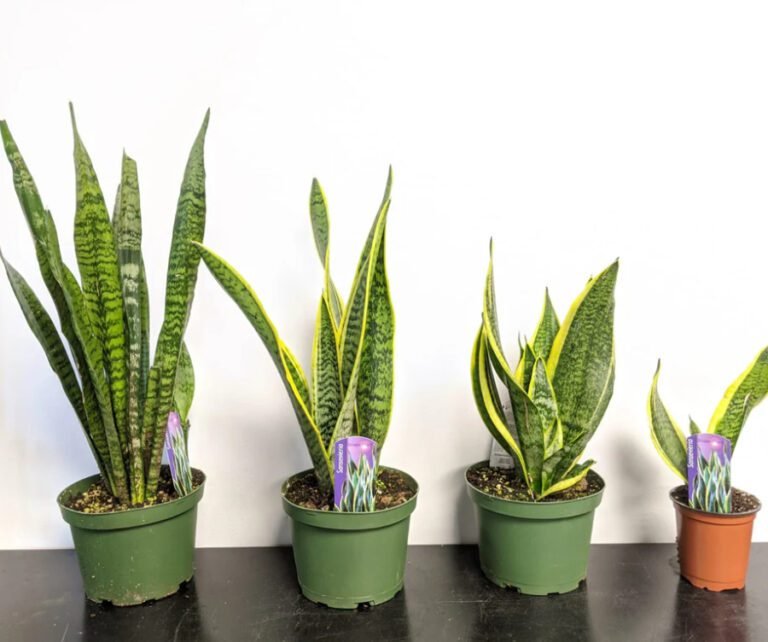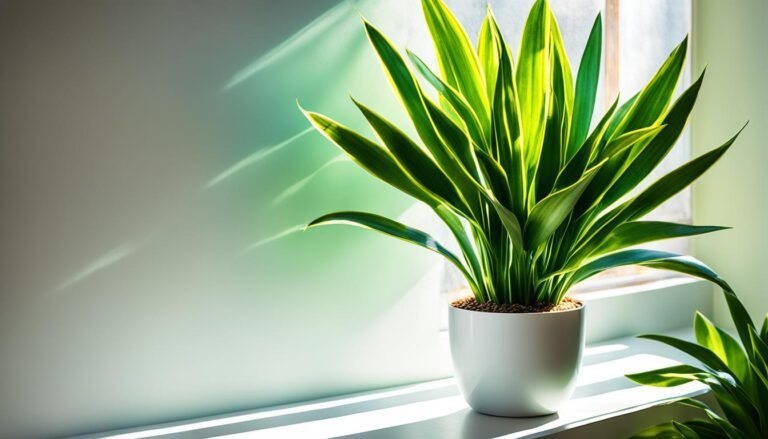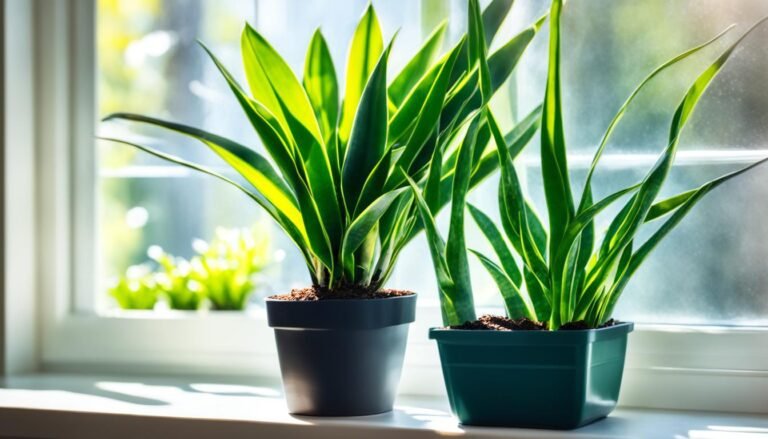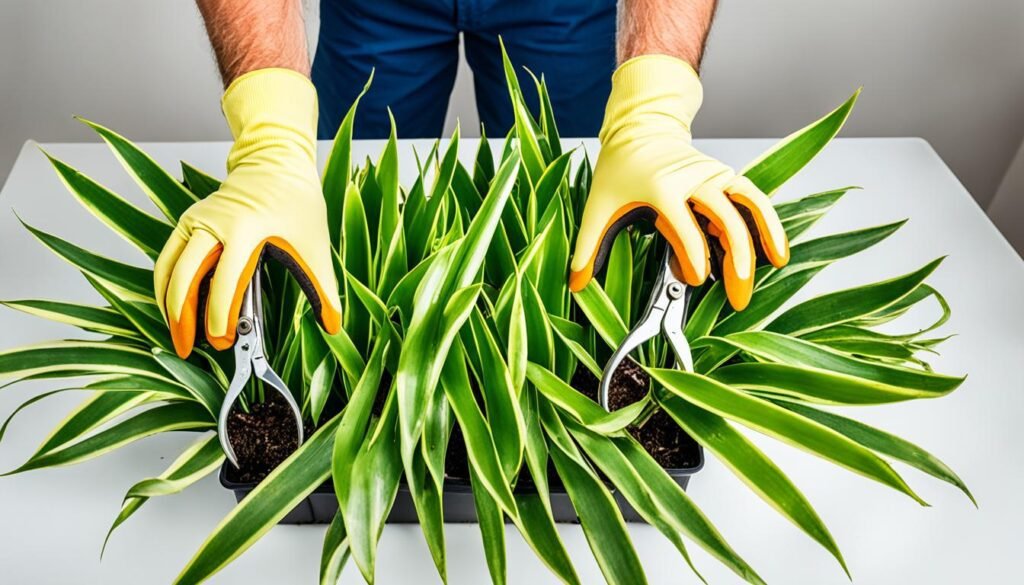Welcome to Snake Plant Care 101. Sansevieria (also known as Mother-in-Law Tongue or Snake Plant) is an amazing and beautiful plant. Sansevieria originally came from Africa and made its way to Europe in the 18th century. It’s by far my favorite plant I have in my home, because it really doesn’t require too much care.
This is my full guide on snake plant care! Whether you love plants or are just beginning to grow them indoors, this article has all you need. You’ll learn how to make your snake plant, also known as Sansevieria, flourish at home.
Snake plants are famous for being easy to care for and cleaning the air. It being so easy to take care of makes it the perfect plant to put everywhere in your home. Lets get right into this Snake Plant Care article.

Introduction to Snake Plant Care
Welcome to Snake Plant Care! You need to know the basics about snake plant care to easily keep the plant healthy.
Snake plants, or Sansevieria, are loved for being easy to care for. Snake plants remove toxins and purify the air, which is just a plus because they are also a really beautiful way to add some green to your home decor.
Caring for snake plants requires just a few important things. You need to get the light, water, food, and pot just right. Giving a little care and time to your snake plants pays off. Let me show you everything you need to know and everything I do to keep my snake plants healthy and cared for.
The Ideal Environment for Sansevieria
Snake plants, or Sansevieria, need certain conditions to flourish. We’ll cover the best light, temperature, and humidity for these plants. This info will help you make the perfect spot for your snake plants.
Optimal Lighting Conditions
Light greatly affects snake plant growth. They do well in bright, indirect light the most. Try placing your plant by a north or east-facing window. This way, it gets the right amount of light without the burn of direct sun.

Best Temperature Ranges
Snake plants like temperatures between 60°F (16°C) and 85°F (29°C). They can handle a bit cooler, down to 50°F (10°C), but not cold or frost. Keep them away from drafty spots to avoid growth issues.
Humidity Preferences
These plants come from dry areas in West Africa, so they’re very much okay with low humidity. Most homes’ dry air suits them fine. Sometimes, a little misting or a water tray nearby helps. But keep them away from very moist areas to avoid problems.
To help your snake plant thrive, give it the right light, temperature, and humidity. Watch these conditions and adjust as necessary. This care will keep your Sansevieria healthy.
| Lighting Conditions | Temperature Range | Humidity Preferences |
|---|---|---|
| Bright, indirect light | 60°F (16°C) to 85°F (29°C) | Low to moderate humidity |
| Avoid direct sunlight | Tolerates down to 50°F (10°C) | Slightly increased humidity may benefit |

Snake plant care: Watering
It’s super important to water your snake plant correctly for its health. We’ll talk about watering frequency, what over or under watering looks like, and why water quality matters for Sansevieria.
How Often Should you Water your snake plant?
You should consider a few things when watering your snake plant. Look at the season, the type of potting mix, and the room conditions. Snake plants like to dry out before you water them again. Too much water can cause root rot. Not enough water makes leaves curl and brown.
To know when to water, check the soil. Push your finger about an inch deep. If the soil feels dry, it’s time to water. If it’s moist, wait a bit longer before watering.
Signs of Overwatering and Underwatering
Knowing the signs of too much or too little water can save your plant.
Signs of too much water:
- Leaves turning yellow or wilting
- Roots that are mushy or rotten
- A bad smell from the soil
Signs you’re not watering enough:
- Leaves drooping or shriveling
- Leaves with dry, crispy edges
- The plant is growing slowly
Water Quality for Sansevieria
Yes, The type of water you use for your snake plant care matters. Sansevieria does okay with different types of water, but it does best with water that doesn’t have chemicals or minerals.
Snake plants do well with filtered or distilled water since it doesn’t have chlorine or other chemicals you find in tap water. If you don’t have filtered water, let tap water sit out overnight. This makes the chlorine evaporate before you use it on your plant.
Snake Plant care: Feeding and Fertilization
Snake plants care is easy because snake plants don’t need much food, but the right nutrients can make them healthier. You have to choose the right fertilizer. A well-fed snake plant grows better.
Pick a fertilizer made for succulents and houseplants as they already have a mix of nutrients that your house plants need.
One of the top choices is a Jobe’s slow-release granular fertilizer. It should have equal parts nitrogen, phosphorus, and potassium. This kind gives your plant a steady flow of food. It helps your snake plant grow strong without getting too much.
You should feed your snake plant every 2-3 months in the warmer months. This is when it grows the most. But don’t feed it in the winter. That’s when it takes a break and rests.

| Fertilizer Name | Key Features | Application Frequency |
|---|---|---|
| Slow-Release Granular Fertilizer | Provides a balanced supply of essential nutrients | Every 2-3 months during the growing season |
| Organic Liquid Fertilizer | Natural and environmentally-friendly option | Every 4-6 weeks during the growing season |
| Cactus and Succulent Fertilizer | Specially formulated for succulents, including snake plants | Every 2-3 months during the growing season |
The table lists different fertilizers you can buy on Amazon for snake plants. It shows what they offer and how often to use them.
Snake plant care: Potting and Soil Composition
Choosing the right pot is important for your snake plant’s health and growth. You should choose a pot that has enough space for your Snake Plant’s root to grow properly. Make sure it has drainage holes to stop water from logging.
For the soil mix, you need something that drains well and is rich in nutrients. Stay away from soils that are heavy and keep moisture. A mix with peat moss or coconut coir, perlite, and coarse sand is best. This helps air get to the roots and keeps the soil from getting too wet.
| Factors to Consider when Choosing a Pot for Your Snake Plant | Best Soil Mix for Snake Plants |
|---|---|
|
|
By getting the right pot and soil for your snake plant, you help it grow strong and healthy. It’s important these provide good drainage and a potting mix that doesn’t hold too much water. This way, your snake plant will always be good.
Snake Plant Care: Pruning and Maintenance
Regular pruning gets rid of dead or damaged leaves is an important part of Snake Plant Care. It also encourages new growth, which will make your plant look fresh and full.
First, check your snake plant for any yellow, brown, or wilted leaves. Then, use clean, sharp pruning shears or scissors to cut these leaves at the base. Always sterilize your tools before and after pruning to avoid spreading diseases. Cut back any leaves that grow too long or in the wrong direction. This keeps your plant looking tidy.
Here are some care tips for your snake plant:
- Wipe the leaves: Dust on the leaves can block sunlight. Clean them with a damp cloth or water with a bit of soap (LITTLE BIT)
- Dust the soil: Dust on the soil can also be a problem. Use a brush or cloth to clean the top layer of the soil.
- Watch for pests: While snake plants often resist pests, stay alert for signs like webbing or tiny bugs. If you find pests, deal with them quickly using treatments or insecticides.
Just like any plant it needs regular pruning and upkeep. Removing dead leaves, shaping the plant, and keeping it clean will keep it healthy and good-looking.

Snake plant care: Propagation Techniques
Snake plants are awesome, right? They’re not just easy on the eyes, but they’re also super easy to propagate! If you’re itching to grow your own snake plant gang or spread the leafy love with pals, here are a few tricks to try out:
Splitting and Dividing: Think of it like giving your snake plant a makeover. Grab that mature plant, gently tease apart those roots into sections, making sure each chunk has some leaves and healthy roots. Pop each section into its own pot with some well-draining soil, and voila! You’ve got yourself a brand new plant or three.
Rooting Cuttings in Water: This one’s like a science experiment you’ll actually want to try. Snip a healthy leaf into a few inches long pieces, plop ’em in water, and let them soak up that sunshine without getting scorched. Keep changing the water, and in a few weeks, you’ll see those adorable roots sprouting. Time to plant them in soil and watch ’em grow!
Planting Snake Plant Cuttings: Feeling like getting your hands dirty? Grab a leaf, chop it up into bits with a little stem and leaf action on each piece, and tuck ’em into pots filled with soil that loves to let water run through. Keep ’em basking in bright light, but don’t let that sunburn ’em! A sprinkle of water to keep the soil moist, and before you know it, you’ll have a mini snake plant army on your hands.
Boom! With these moves, you’ll be a snake plant propagating pro in no time. Plus, it’s a budget-friendly way to fill your space with green goodness. It’s a Win-win!
Snake Plant Care: Common Issues and their Solutions
Snake plants are like the low-maintenance buddies of the plant world, but even they can hit a rough patch sometimes. Let’s dive into the common hiccups snake plant owners might face and how to kick ’em to the curb.

Snake plants are like the low-maintenance buddies of the plant world, but even they can hit a rough patch sometimes. Let’s dive into the common hiccups snake plant owners might face and how to kick ’em to the curb.
Battling Pests and Diseases: Uh-oh, unwanted guests crashing the plant party? Keep an eye out for spider mites, mealybugs, and scale insects. These annoying little things are so bad for your plant’s leaves. Grab a damp cloth or some insecticidal soap to show ’em who’s boss. Regular check-ups on your plant can help catch these troublemakers early on.
Dodging Root Rot and Other Water Woes: Too much water or poor drainage can turn your snake plant’s roots into mush. Not a good look. Keep things in check by watering smart and using soil that knows how to let excess water escape. If you spot yellowing leaves or wilting, it’s time to rethink your watering game and give your plant some breathing room.
Nailing the Right Environment: Snake plants aren’t picky, but they do have their preferences. They dig temperatures between 60-85°F (16-29°C) – too hot or too cold can make ’em cranky. And they’re all about that moderate to high humidity life, so keep ’em comfy with a humidity tray or a handy humidifier. Bright, indirect light is their jam, so if they’re not feeling the glow, consider giving them a new spot or some grow lights.
Tackling Leaf Curling and Other Headscratchers: If your snake plant’s leaves are doing the curly shuffle, it might be a sign they’re thirsty, chilly, or just not feeling the vibe of their environment. Check the water situation and surroundings, and tweak your care routine accordingly.
Here’s a guide to common snake plant issues and solutions:
| Issue | Cause | Solution |
|---|---|---|
| Pests | Spider mites, mealybugs, scale insects | Remove pests manually, use insecticidal soap |
| Diseases | Root rot, fungal infections | Improve drainage, adjust watering routine |
| Environmental Stress | Temperature extremes, low humidity, insufficient lighting | Maintain suitable temperature and humidity levels, provide adequate lighting |
| Curling Leaves | Overwatering, underwatering, cold temperatures | Adjust watering schedule, ensure proper temperature conditions |
| Other Common Problems | Yellowing leaves, brown tips, stunted growth | Assess care practices, adjust watering, lighting, and nutrient levels |
Snake Plant Care: FAQ
How often should I water my snake plant?
Snake plants prefer to dry out between watering. Water them thoroughly, then allow the soil to dry completely before watering again. Typically, once every 2-6 weeks depending on the humidity and temperature of your home.
What kind of light does a snake plant need?
Snake plants thrive in indirect light but can tolerate low light conditions. Place them near a window where they can receive some sunlight but avoid direct sunlight, as it can scorch their leaves.
How do I repot a snake plant?
When repotting a snake plant, choose a pot that is slightly larger than its current one. Use well-draining soil and gently remove the plant from its old pot. Place it in the new pot, filling in with soil around the roots, and water thoroughly
How do I propagate a snake plant?
Snake plants can be propagated through division or leaf cuttings. For division, carefully separate the rhizomes and plant them in their own pots. For leaf cuttings, cut a healthy leaf into sections and place them in soil to root.
Why are the leaves of my snake plant turning yellow?
Yellowing leaves on a snake plant can indicate overwatering or underwatering. Check the soil moisture and adjust your watering schedule accordingly. Ensure the pot has proper drainage to prevent waterlogging.
Do snake plants need fertilizer?
Snake plants are low-maintenance and can thrive without regular fertilization. However, you can feed them diluted, balanced fertilizer during the growing season (spring and summer) to encourage growth.
Are snake plants toxic to pets?
Yes, snake plants are toxic to pets if ingested. Keep them out of reach of curious pets and consider choosing pet-friendly houseplants if you have pets that like chewing random things like plants.
How do I care for a snake plant in winter?
During winter, reduce watering frequency as snake plants enter a dormant phase. Place them in a warm location away from cold drafts and ensure they still receive adequate indirect light. Avoid overwatering, as the plant’s growth slows down in cooler temperatures.
Can snake plants grow in low light?
Yes, snake plants can tolerate low light conditions, although they may grow more slowly compared to those in brighter light. Place them in a well-lit room away from direct sunlight for best results.
How do I prevent root rot in my snake plant?
To prevent root rot, ensure your snake plant is potted in well-draining soil and a pot with drainage holes. Avoid overwatering and allow the soil to dry out between waterings. If you suspect root rot, inspect the roots for mushiness and consider repotting into fresh, dry soil.
Snake Plant Care: conclusion
Now that you’ve gone through the guide on snake plant care, you’re ready to look after your Sansevieria. If you keep to these steps you’ll love how your snake plant looks and it’ll beautify your home and last for years and years. Feel free to save this point using the small button on the bottom right of your screen so you can always come back to check if you need to refresh your mind. Looking after snake plants makes your home look good and the air cleaner. So do what you need to ❤️
























